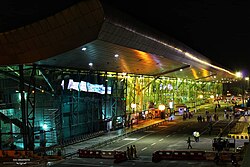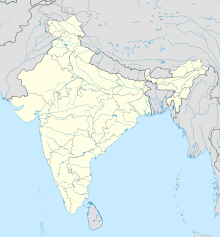avia.wikisort.org - Aerodrome
Sri Guru Ram Das Ji International Airport (IATA: ATQ, ICAO: VIAR) is an international airport serving Amritsar, Punjab, India, located 11 km (7 mi) north-west from the city centre. It is named after Guru Ram Das, the fourth Sikh Guru and the founder of Amritsar. The airport is the largest and the busiest airport of Punjab. It is the second-largest airport in Northern India after Indira Gandhi International Airport in Delhi.[4] The airport was the 3rd fastest-growing airport in India during the fiscal year 2017–18.[5] It is a hub of cargo movements, domestically and internationally.[6] The airport is ranked the 6th-best regional airport in India and Central Asia in 2019 and 2020 by Skytrax.[7] The airport is awarded as the best airport in Asia-Pacific in 2020 (2 to 5 million passengers per annum) by Airports Council International.[8]
Sri Guru Ram Das Ji International Airport | |||||||||||
|---|---|---|---|---|---|---|---|---|---|---|---|
 | |||||||||||
| |||||||||||
| Summary | |||||||||||
| Airport type | Public | ||||||||||
| Operator | Airports Authority of India | ||||||||||
| Serves | Amritsar, Punjab, India | ||||||||||
| Location | Raja Sansi, Amritsar, India | ||||||||||
| Opened | 1930 | ||||||||||
| Focus city for | |||||||||||
| Elevation AMSL | 230 m / 756 ft | ||||||||||
| Coordinates | 31°42′28″N 074°47′57″E | ||||||||||
| Website | Amritsar Airport | ||||||||||
| Map | |||||||||||
 ATQ Location of airport in Punjab  ATQ ATQ (India) | |||||||||||
| Runways | |||||||||||
| |||||||||||
| Statistics (April 2021 - March 2022) | |||||||||||
| |||||||||||
History
In 1930, Amritsar Airport was established during the British tenure and was used for VVIP movements. After independence, it got connected with Delhi and Srinagar. The first international flight to Kabul was launched in 1960. In 1982, Air India started direct international flight from Amritsar to Birmingham (UK) with a stop at Moscow and this flight became so popular that it was termed as no.1 flight for Air India. However, Air India stopped its operation at Amritsar Airport due to Operation Blue Star in 1984. Turkmenistan Airlines and Uzbekistan Airways started their flights in 2000 from and to Ashgabat and Tashkent, connecting Birmingham and London Heathrow. A series of charter flights started from Birmingham, London Gatwick, Milan, Vienna, Bratislava to Amritsar, during 2003 to 2011, which have been discontinued. Singapore Airlines started flying thrice weekly in 2004, which was discontinued in 2009. Various international flights started from Amritsar during 2006 - Jet Airways to London from August 2006 to November 2008, Transero Airlines to Moscow from October 2006 to May 2008, Mahan Air to Tehran from July 2009 to 2011, Air India Express to Muscat and Abu Dhabi from August 2009 to April 2012, Air India/Indian Airlines to Sharjah from December 1997 to April 2012, BMI to London from November 2011 to October 2012, all flights have been discontinued. In November 2010, Rajasansi International Airport's name was changed to Shri Guru Ram Dass Jee International Airport.
Facilities

In July 2001, the construction of Phase 1 terminal building started, along with the extension of the existing runway, construction of a new air traffic tower and other works. The construction of all Phase 1 works finished in June 2006. The arrivals section of Phase 1 terminal building was inaugurated in September 2005, and the departures section was made operational in March 2006. Over the years, the old terminals (existing and Phase 1) were systematically razed, paving way for a new integrated terminal building (Phase 2), built in glass and steel and equipped with modern facilities like an inline X-ray baggage inspection and conveyor system, Flight Information Display System (FIDS), Common Use Terminal Equipment (CUTE), and CCTV for surveillance among others, which was inaugurated on 25 February 2009, with an area of approximately 40,175 square metres (432,440 sq ft), marking an improvement over the earlier 12,770-square-metre (137,500 sq ft) facility. The integrated building is a blend of modern and Indian designs, constructed in glass and steel with Indian style arches and colours. For the quarter ending 30 June 2016, the airport registered a 59.6% growth of international passenger traffic.[9]
The integrated terminal building has four aerobridges, an annual capacity of 1.46 million passengers with a peak hour capacity of 1,200 passengers. The building has 30 check-in counters, 4 X-ray scanners (for baggage), 26 immigration counters, 10 custom counters, 12 security check booths, and 4 conveyor belts for arrivals. The apron has been extended to cater for parking of a total of 25 aircraft (8 Category 'E', 3 Category 'D' and 13 Category 'C' types of aircraft & 1 category 'E' for cargo) from the earlier capacity of 15 aircraft and strengthened for parking of Category 'C' type of aircraft. The departure and arrival halls operate duty-free shops. The departure hall also accommodates foreign currency exchange service, restaurants and other shops for the convenience of departing passengers.[10] The airport registered India's highest passenger growth of over 48% for the year 2017–2018.[11] Currently, the flights coming in the airport connect it direct to over 20 destinations across India and other countries.
Terminal

The Amritsar Airport is spread over an area of 40,000 sq. meters with 30 check-in counters, 26 immigration counters, 12 custom counters, and 2 security check booths and can handle 600 passengers at arrival and 600 passengers at departure.
Runway
The Airport is a CAT III ILS compliant airport.[12][13] During 2016–17 runway upgrade, the flexible portion runway was strengthened and inset lighting installed for ILS CAT III at a cost of 1.5 billion rupees.[14] On 12 October 2017, the Airports Authority of India issued CAT III-B low visibility procedures (LVP) for Amritsar Airport allowing landing at 50 m visual range.[15] Before Installation of CAT III ILS, CAT II ILS became operational on 23 December 2011 and reduced the visibility requirement for an aircraft landing at Amritsar Airport on Runway 34 from the existing 650 metres to 350 metres benefiting airlines in increased safety and avoiding diversions to other airports resulting in better operational and environmental efficiency.
Airlines and destinations



| Airlines | Destinations |
|---|---|
| Air India | Birmingham, Delhi, London–Heathrow, Mumbai |
| Air India Express | Dubai–International, Sharjah |
| Batik Air Malaysia | Kuala Lumpur–International |
| Go First | Delhi, Mumbai, Srinagar |
| IndiGo | Bangalore, Delhi, Goa, Jammu, Kolkata, Lucknow, Mumbai, Pune, Sharjah, Srinagar |
| Neos | Milan–Malpensa[16][17] Seasonal: Malé |
| Qatar Airways | Doha |
| Scoot | Singapore |
| SpiceJet | Ahmedabad, Delhi, Dubai–International, Jaipur, Patna |
| Vistara | Delhi |
Statistics
Future Plans
Considering the High Traffic at Airport, The Ministry of Civil Aviation has proposed to expand the current integrated passenger terminal at the cost of 240 Crore, the existing capacity of 2.5 Million Passengers per annum will increase to 5.5 Million Passengers per annum.
Along with this projects costing 60 Crores have been approved for construction of addition aprons, parking stands of aircraft and upgrading of terminal building. Projects have been approved and are expected to complete on schedule.
Amritsar Airport is also proposed to leased out for privatisation on a Public Private Partnership basis, along with 5 other major airports of Airports Authority of India. With privatisation, the infrastructure at airport is expect to improve further.
With the completion of Delhi–Amritsar–Katra Expressway which is currently under construction, the travel time from Amritsar Airport to Delhi Airport will half from current 8 hours to 4 hours.[18] This will likely result in negative passenger enplanement growth for this route.
Connectivity
Road
The Airport is connected by 4 lane National Highway 354, which runs from Amritsar to Ajnala. Taxi can be taken from the taxi stand of the airport. Both Ola Cabs and Uber are available in the city. Autos and local buses also connect the city to the airport.
Metrobus
Sri Guru Ram Dass Jee International Airport is connected by Route 501 of Amritsar Metrobus which connects it directly to Amritsar Junction, Golden Temple and many other locations in the network of Amritsar Metrobus. MetroBus operated at a frequency of every 10–15 minutes.[19][20]
See also
- Aviation in India
- Golden Temple
- Amritsar Metrobus
- Amritsar Ring Road
- List of airports in India
- List of the busiest airports in India
References
- "Annexure III - Passenger Data" (PDF). www.aai.aero. Retrieved 19 June 2022.
- "Annexure II - Aircraft Movement Data" (PDF). www.aai.aero. Retrieved 19 June 2022.
- "Annexure IV - Freight Movement Data" (PDF). www.aai.aero. Retrieved 19 June 2022.
- Airports Authority of India [@AAI_Official] (7 September 2020). "#AAI's Amritsar Airport @aaiasrairport, the second largest airport of Northern Region, was strategically set up to ease @DelhiAirport's operational load.#IconicAirportTerminals t.co/fZG66TAA3d" (Tweet). Retrieved 9 January 2021 – via Twitter.
- C, D. "Amritsar beats all international Airports in India with 83.5% growth in domestic traffic - Asian Independent".
- Airports Authority of India [@AAI_Official] (11 December 2020). "#AAI's Amritsar @aaiasrairport has been a hub of cargo movements, domestically and internationally. The airport continues to thrive in delivering essentials and other necessary items across the globe, smoothly. #DeliveringHappiness t.co/lpyjfSWpZG" (Tweet). Retrieved 9 January 2021 – via Twitter.
- "The World's Best Regional Airports 2021".
- "2020 - Best Airport by Size and Region".
- Khare, Harish (30 August 2016). "59.6% increase in passenger footfall at Amritsar airport". Tribuneindia.com. Retrieved 12 March 2017.
- Press Release By PIB http://pib.nic.in/release/release.asp?relid=47938
- "Amritsar airport tops country in terms of passenger growth | punjab | amritsar | Hindustan Times". M.hindustantimes.com. 22 April 2016. Retrieved 20 June 2018.
- "Amritsar Airport ushers in CAT II Instrument Landing System" (PDF). Retrieved 12 March 2017.
- "Airports Authority of India". www.aai.aero. Retrieved 31 December 2015.
- "Amritsar airport set for night flights after runway revamp". Tribuneindia.com. 30 April 2017. Retrieved 14 November 2017.
- "Low Visibility Procedures" (PDF). 9 December 2017. Archived from the original (PDF) on 9 December 2017. Retrieved 20 June 2018.
- Singh, Ravreet (17 August 2022). "Neos Airlines Ramps-Up Capacity Between Amritsar And Milan, Italy". FlyAmritsar. Retrieved 19 September 2022.
- Casey, David (7 September 2022). "ITA Adds India and Japan Routes". Routes Online. Retrieved 20 September 2022.
- "अमृतसर हवाईअड्डे का 300 करोड़ से विकास होगा".
- "एयरपोर्ट से घी मंडी तक भी जाएगी बीआरटीएस बस, 15 रुपये होगा किराया".
- "Amritsar Metro Bus Services".
External links
![]() Media related to Sri Guru Ram Dass Jee International Airport at Wikimedia Commons
Media related to Sri Guru Ram Dass Jee International Airport at Wikimedia Commons
На других языках
[de] Flughafen Amritsar
Der Flughafen Amritsar (englisch Amritsar Airport; auch Sri Guru Ram Das Jee International Airport) ist ein internationaler Flughafen ca. 11 km nordwestlich der Millionenstadt Amritsar im nordindischen Bundesstaat Punjab. Der zweitgrößte Flughafen Nordindiens ist nur etwa 15 km von der Grenze zu Pakistan und somit etwa 40 km von der Millionenstadt Lahore entfernt.- [en] Sri Guru Ram Dass Jee International Airport
[es] Aeropuerto Internacional Sri Guru Ram Dass Jee
El Aeropuerto Internacional Sri Guru Ram Dass Jee (IATA: ATQ, OACI: VIAR) es un aeropuerto que sirve a la ciudad de Amritsar, Punyab, India. Hasta allí llegan vuelos procedentes de Birmingham, Dubái, Doha y Tashkent, entre otras ciudades. Se encuentra cerca del pueblo de Rajasansi, aproximadamente 11 kilómetros (7 mi) al noroeste de Amritsar.[fr] Aéroport international Guru-Ram-Das
L’aéroport international Raja Sansi (code IATA : ATQ • code OACI : VIAR) est situé à Amritsar en Inde.[ru] Международный аэропорт имени Раджа Санси
Международный аэропорт имени Раджа Санси (англ. Sri Guru Ram Dass Jee International Airport) (ИАТА: ATQ, ИКАО: VIAR) — аэропорт в Индии, расположен в 11 километрах от города Амритсар в поблизости от деревни Раджа Санси. Аэропорт обслуживает штаты Пенджаб, Химачал-Прадеш, Джамму и Кашмир. Аэропорт является самым быстрорастущем по пассажиропотоку в Индии.Другой контент может иметь иную лицензию. Перед использованием материалов сайта WikiSort.org внимательно изучите правила лицензирования конкретных элементов наполнения сайта.
WikiSort.org - проект по пересортировке и дополнению контента Википедии